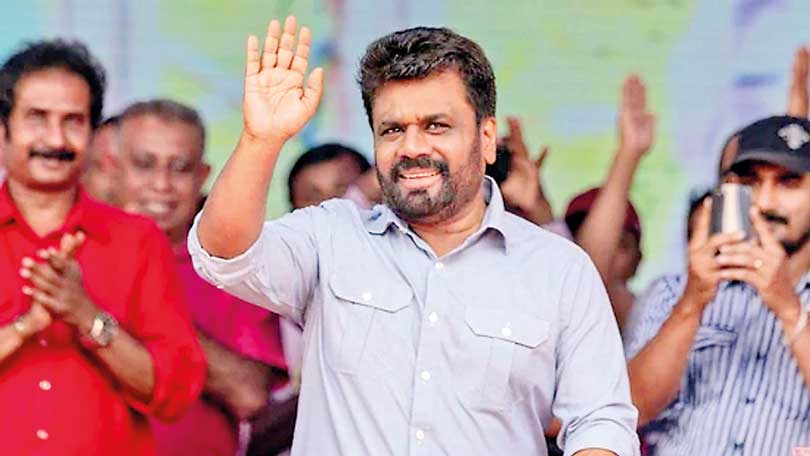Monday Mar 31, 2025
Monday Mar 31, 2025
Tuesday, 24 September 2024 00:03 - - {{hitsCtrl.values.hits}}

All the debate about Sri Lanka’s current state of sovereign default implies a much deeper question: what is the macroeconomic framework that the NPP will adopt?
 With Sri Lanka continuing to reel from the economic crisis, the popular frustration paved the way for the victory of the NPP candidate, Anura Kumara Dissanayake, in the recent Presidential election. Meanwhile, as indicated by the premature announcement of a settlement with bondholders just days earlier, the complex question of debt restructuring hangs like a shadow over the incoming Government. It invokes a web of international actors led by the IMF who apply pressure at different levels.
With Sri Lanka continuing to reel from the economic crisis, the popular frustration paved the way for the victory of the NPP candidate, Anura Kumara Dissanayake, in the recent Presidential election. Meanwhile, as indicated by the premature announcement of a settlement with bondholders just days earlier, the complex question of debt restructuring hangs like a shadow over the incoming Government. It invokes a web of international actors led by the IMF who apply pressure at different levels.
The NPP-led Government will be compelled to engage them and, when and where necessary, push back. But all the debate about Sri Lanka’s current state of sovereign default implies a much deeper question: what is the macroeconomic framework that the NPP will adopt? And to what extent, if any, can it resolve the underlying development crisis brought about by the decades-long trajectory of the ‘open economy’, which culminated in the default?
Old and new assumptions
Answering these interrelated questions is challenging, but not impossible. First and foremost, we must revisit earlier economic assumptions from a clear-eyed historical perspective. Many analogies have been drawn between the Great Hartal of 1953 and the election of SWRD Bandaranaike in 1956, which entailed a shift towards dirigisme, or an explicit style of State intervention in the economy. Does the contemporary sequence between the aragalaya and the 2024 election anticipate a similar trajectory? For our purposes, the specific difference in our understanding of the shift is the degree to which the Bandaranaike Government challenged the assumptions behind the report of the International Bank for Reconstruction and Development (IBRD) mission to Sri Lanka (Ceylon at the time), published in 1953. Can the NPP produce an economic paradigm shift of a similar magnitude today?
The Bandaranaike Government committed to a move towards State intervention, specifically to promote import substitution, including the heavy goods industries required to provide basic inputs to the economy. Meanwhile, the IBRD report asserted that Sri Lanka should focus on non-plantation export agriculture, without trying to adopt industry too quickly. Such a strategy would have inevitably locked the country into a persistent pattern of underdevelopment, because of declining terms of trade for the country’s primary products. The report also contained the infamous recommendation to cut the rice subsidy, which sparked the hartal. But it nevertheless demonstrated a level of clarity in its macroeconomic assumptions, which was startling absent in the most recent IMF Agreement signed in 2023.
Of course, for newly independent countries such as Sri Lanka, the problem of development was unavoidable. Even Western policy makers, anti-communist and often stubbornly colonial in their mentality, were nevertheless forced to recognise that the aspirations of populations in countries such as Sri Lanka could not be ignored. Perhaps that is why they explicated their framework in such a clear manner. One of the most telling lines in the IBRD report is the following in response to the question of the relationship between a growing national income and a higher propensity to import goods: “Is this likely to mean such a rise in imports as to exceed substantially earnings from exports, and thus to cause continuing and mounting balance of payments deficits? Granted the assumptions within which we are working, it is our opinion that this outcome is not only unlikely but impossible on any large scale.” The IBRD report goes on to summarise its reasoning, arguing, “Such an increase could only occur and be long maintained if the spending power of the public were supported by inflationary measures, which we have assumed will be avoided.”
The crux of the problem is that these same assumptions do not hold today. The IBRD staff were working in a world of ‘embedded liberalism’, in which capital controls predominated and the extensive outsourcing of transnational companies was practically unthinkable, not to mention the increasingly extravagant consumption of the comprador classes. As we can now see, the same conditions no longer apply. More importantly, with the opening of the economy in the late 1970s, the extent to which Sri Lanka ended up financing its ‘twin deficits’—the current account and the fiscal—with a shift from redistributive taxation to external commercial borrowing paved the way for the present crisis. To try and resist this pattern, however, seems to imply an impractical move away from the global economy back to a closed one. According to critics, this is a wholly untenable proposition, especially when portrayed in such black-and-white terms.
But the challenge for an incoming NPP-led Government, if it is serious about addressing not only the immediate relief needs of the country, but the entire macroeconomic framework in which assumptions about debt restructuring are embedded, is precisely to map new relationships. They have been engendered by major changes in the global economy. The methods of inquiry themselves, however, need not be novel. In fact, the field of development economics has been at the forefront for decades. It has long recognised the degree to which the economies of developing countries reveal entirely different stylised facts, including a much higher degree of structural underemployment, which require theories that can accommodate them.
This is true even if such constructs diverge from the mainstream neoclassical assumptions that dominate the representation of the economies of advanced industrial countries. Tellingly, however, even in the latter, climate change along with the new wave of geopolitical conflict has sparked an intense interest in reclaiming tools that had long been rejected under the neoliberal consensus. That includes explicit use of industrial policy to develop strategic sectors.
Making development possible again
Too often, such debate about the underlying objects and methods of economics can seem abstract. This may be true twice over because the incoming NPP-led Government will immediately be staring down the barrel of powerful external bondholders and their institutional allies, such as the IMF. It will be forced to react quickly, responding to international media narratives about a coalition with a suspicious ‘Marxist’ background that must supposedly prove its fealty to neoliberal norms. But the question of development should not be dismissed as idle speculation.
In fact, it is core to whichever assumptions will be made not only about how Sri Lanka can deal with its fiscal constraints, but what precisely the country can achieve under tight circumstances. While the details of a debt restructuring framework remain to be worked out, only a programme of economic recovery embedded in a tangible vision of development can offer the most compelling reason for asserting why one fiscal target is necessary over another. Why is a specific growth number crucial? And if the economy will take years to recover regardless, what kind of expansion in critical areas is even possible? Towards this end, any serious attempt to reveal the limits of the existing IMF Agreement requires further engagement with the mechanisms and tools any government must quickly adopt to deal with the enormous crisis that Sri Lanka’s working people especially continue to face.
Perhaps a starting point would be the one offered by eminent economists such as Nicholas Kaldor. As part of a visiting team under the Bandaranaike Government, they challenged the assumptions of the IBRD report. They produced a set of papers in 1959 that offered a distinct alternative nevertheless grounded in masterful command of development economics. In his paper for the edited volume, Kaldor argued that Sri Lanka should consider a Planning Committee of the Cabinet, “(consisting of all the Ministers who have a direct responsibility for the various sectors) with the Ministers being free to delegate their responsibility to their permanent officials, in the day-to-day work of the Committee itself, or of its various sub-committees, provided only that the officials can speak with authority for their Ministers and Departments.”
If the NPP is serious about providing not just a change in government, but the very trajectory of the development of the country, then it will have to grapple with the genealogy of these planning proposals along with contemporary mechanisms that imply further innovation. In addition, it would need to develop a clear and consistent view of Sri Lanka’s development model, particularly the need to prioritise self-sufficiency in food production. It must identify stylised facts, or features, of the country’s economy that would enable it to thrive on its material endowment without being locked into the kinds of ‘comparative advantage’ entrenched in today’s extremely unequal global economy. That includes Sri Lanka’s overreliance on an extremely narrow basket of export goods, namely textiles and garments.
Such trends in the global economy are further driven by the interests of powerful financial actors and transnational conglomerates increasingly aligned with the Great Power objectives of their respective States. To resist the tendency towards a new wave of dispossession, an actual progressive vision of Sri Lanka’s development would require generating a much deeper, endogenous view, driven by the needs of its working people. This is true whether they labour on farms, in fisheries, or at home through the subtle yet pervasive forms of caregiving that sustain the entire society. Will we see a real shift in the core style of governing, and not just a replacement of the State’s leading personnel? Will the NPP make good on its promise not only for relief to the beleaguered people, but for development in its widest sense?
Discover Kapruka, the leading online shopping platform in Sri Lanka, where you can conveniently send Gifts and Flowers to your loved ones for any event including Valentine ’s Day. Explore a wide range of popular Shopping Categories on Kapruka, including Toys, Groceries, Electronics, Birthday Cakes, Fruits, Chocolates, Flower Bouquets, Clothing, Watches, Lingerie, Gift Sets and Jewellery. Also if you’re interested in selling with Kapruka, Partner Central by Kapruka is the best solution to start with. Moreover, through Kapruka Global Shop, you can also enjoy the convenience of purchasing products from renowned platforms like Amazon and eBay and have them delivered to Sri Lanka.
Discover Kapruka, the leading online shopping platform in Sri Lanka, where you can conveniently send Gifts and Flowers to your loved ones for any event including Valentine ’s Day. Explore a wide range of popular Shopping Categories on Kapruka, including Toys, Groceries, Electronics, Birthday Cakes, Fruits, Chocolates, Flower Bouquets, Clothing, Watches, Lingerie, Gift Sets and Jewellery. Also if you’re interested in selling with Kapruka, Partner Central by Kapruka is the best solution to start with. Moreover, through Kapruka Global Shop, you can also enjoy the convenience of purchasing products from renowned platforms like Amazon and eBay and have them delivered to Sri Lanka.